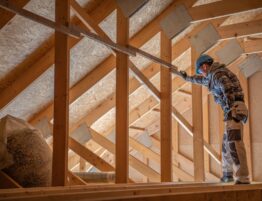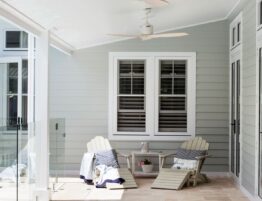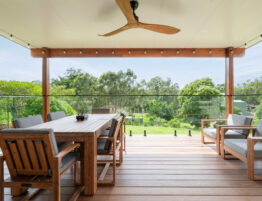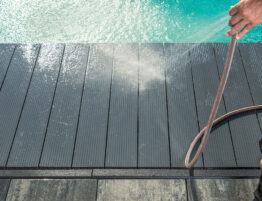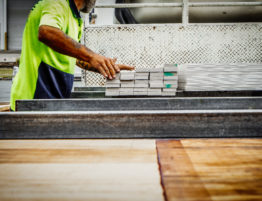
When it comes to modern homes, the exterior is just as important as the interior. Choosing the right cladding material can enhance the aesthetic appeal of your home, while providing essential protection against the elements. With an array of home cladding options however, it can be difficult to determine the best suited option for you and your home. In this article, we’ll explore the various materials that create the best cladding for homes, focusing on options that are both stylish and sustainable.
What is Cladding
Cladding refers to the application of one material over another, providing a layer that enhances aesthetics, provides protection from weather elements and enhances insulation properties. It’s a crucial component of any modern home, offering both protection and visual appeal to your exterior.
Timber Cladding
The ideal material for those seeking a natural, warm appearance. Timber cladding is versatile and can be used in various home design styles, from rustic to contemporary. Popular kinds of wood used for cladding include cedar, redwood, and pine, due to their higher natural resistance to decay and insects, over other options. Timber is not only an aesthetically attractive option, it is also considered environmentally friendly if sourced ethically.
Pros:
- Natural and warm aesthetic
- Sustainable cladding material
- Good insulation properties
Cons:
- Requires regular maintenance
- Can be susceptible to pests and rot
Metal Cladding
Metal cladding offers a sleek, modern look ideal for contemporary homes. Utilising materials such as aluminium and steel. It’s the perfect low-maintenance option due to durability, fire-resistance, and ability to be coated with different finishes that prevent further corrosion. Additionally, finishing coats have the ability to further enhance or tailor visual appeal.
Pros:
- Durable and long-lasting
- Minimal maintenance
- Fire-resistant
Cons:
- Can be expensive
- Limited insulation properties
Brick Cladding
A timeless option that can be tailored to suit both traditional and modern homes. Brick cladding offers excellent insulation and fire resistance, making it a highly durable option within the spectrum of home cladding options. Available in a variety of colours and patterns, to help achieve any desired aesthetic.
Pros:
- Long-lasting and durable
- Excellent insulation
- Fire-resistant
Cons:
- Can be heavy, requiring strong structural support
- Limited design flexibility
Stone Cladding
Luxurious and sophisticated in appearance–stone cladding is available in a variety of natural stones, including granite, marble, and limestone. It’s not only a visually appealing option however, it provides good insulation and high durability.
Pros:
- Luxurious and sophisticated look
- Durable and weather-resistant
- Good insulation
Cons:
- Expensive
- Can be heavy and difficult to install
Sustainable Cladding Materials
Fibre Cement Cladding
Made from a mixture of sand, cement, and cellulose fibres, fibre cement cladding is an innovative option. Known for its durability when installed professionally and resistance to fire, pests, and rot. It’s not only an environmentally friendly option, but typically a budget friendly option also when factoring in its longevity. Aesthetically fibre cement cladding is a versatile choice, capable of mimicking the appearance of wood or stone.
Pros:
- Durable and low-maintenance
- Fire-resistant and pest-resistant
- Versatile in appearance
Cons:
- Can be more expensive than other options
- Requires professional installation
Recycled Plastic Cladding
Recycled plastic cladding is an eco-friendly option that uses repurposed materials to create a durable and low-maintenance exterior. It’s available in a range of colours and styles, offering flexibility for modern home designs.
Pros:
- Environmentally friendly
- Durable and low-maintenance
- Resistant to pests and rot
Cons:
- Can have a synthetic appearance
- Limited colour and design options
Green Wall Cladding
Want something really different? Green wall cladding, also known as living walls, involves using plants as an external cladding material. One of the best cladding for homes trying to achieve a visually unique look. Simultaneously it offers environmental benefits, such as improved air quality and natural insulation.
Pros:
- Enhances air quality
- Natural insulation
- Unique and attractive appearance
Cons:
- Requires ongoing maintenance
- Limited to suitable climates
Choosing the Best Cladding for Your Home
When selecting cladding for your home, factors such as climate, budget, and the desired aesthetic play a large role in decision-making. Sustainable options, such as fibre cement and recycled plastic cladding, are excellent choices for environmentally conscious homeowners. Meanwhile, traditional materials like timber and brick offer timeless visual appeal.
Get high-quality materials from Trade Builders
Whether you prioritise sustainability, durability, or aesthetics when constructing your home’s exterior, Trade Builders has the best cladding supplies for homes, with materials to suit your style and budget, all sourced from a variety of high-quality suppliers. Reach out to us today, to make sure you have the right materials to protect and elevate your home’s exterior.

